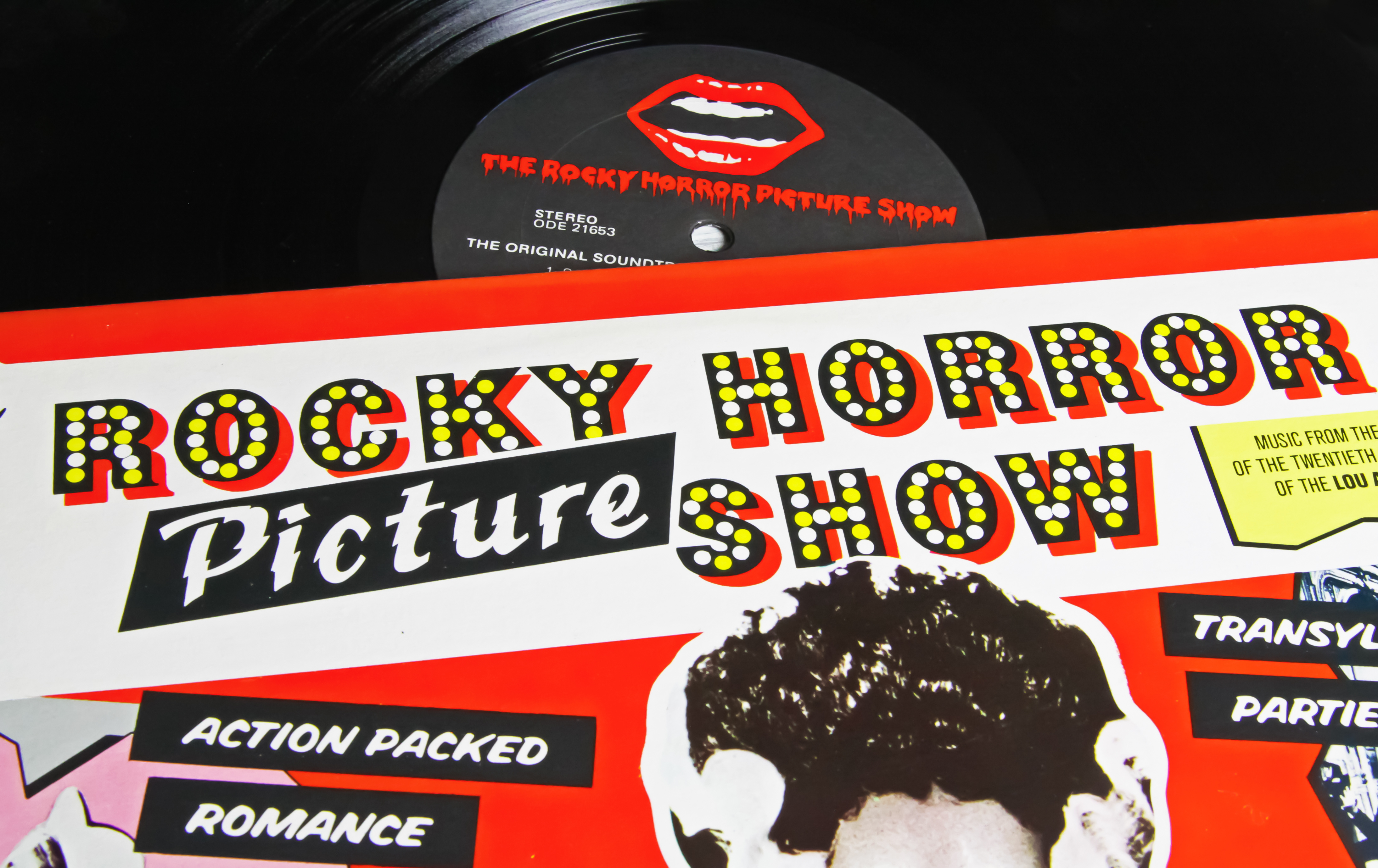At 50, The Rocky Horror Picture Show is ‘imperfectly’ good (and queer) as ever

Closeup of vinyl record cover of movie soundtrack rocky horror picture show. (Credit: Ralf - stock.adobe.com)
In summary
Analysis for The Conversation by film and TV studies experts Dr Craig Martin and Dr Joanna McIntyre
For half a century, The Rocky Horror Picture Show has lured costumed fans to cinemas for late-night screenings. Its raunchy mix of Broadway musical, science fiction and schlock horror was originally a box-office flop. However, after its first midnight screening on April Fool’s Day 1976 at the Waverly theatre in New York, it never left the late-night circuit and became the ultimate cult film.
Tim Curry’s powerhouse performance as Frank-N-Furter is central to the film’s success. Yet, his truly astounding work often overshadows the film’s many other dynamic performances.
Rocky Horror’s supporting characters and chorus feature alluring oddballs who irreverently challenge norms of physical desirability. Their “imperfect” bodies are not only a tribute to diversity: they radically upturn genre expectations of stage and screen musicals, and discredit broader cultural ideals of beauty.

It’s so dreamy, oh fantasy free me!
Brad Majors (Barry Bostwick) and Janet Weiss (Susan Sarandon) are an attractive young couple seeking help at an isolated castle when their car blows a tyre. During their night, they find the castle’s inhabitants are of a variety of sizes, physiques and galaxies.
Adapted from Richard O'Brien’s 1973 stage musical, Rocky Horror’s anti-Broadway aesthetic is apparent as soon as the “butler” Riff Raff (O'Brien) opens the castle door. This wiry framed hunchback with tangled hair is a far cry from the athletic ideal of the Broadway body.
Inside the creepy mansion, we are dazzled by a festive troupe of alien “Transylvanians” wearing off-beat tuxedos and textured waistcoats. It’s a broad assortment of unconventional body types squeezed into colourful costumes.
Lanky actor Stephen Calcutt stands at 198 centimetres tall, and Sadie Corré at just over 120cm. Hugh Cecil, then 62, has alopecia, which exaggerates his stark monocled whiteness. Fran Fullenwider, with her wild, teased-out coiffure and curvy frame, is clad in skin-tight pants.
Cecil and Fullenwider were among a handful of Transylvanians director Jim Sharman recruited from London-based Ugly Models. While this agency’s name and viability is, to say the least, unfortunate, Rocky Horror’s rejection of cookie-cutter casting was celebratory, not diminishing.
The Transylvanians’ subversion of “sameness” is especially powerful because of the history of its film genre. Busby Berkeley, one of film musicals’ founding innovators in the 1930s and 1940s, is famously quoted as approving the “girls” in his ensembles as being “matched, just like pearls”.
Inverting such sexist tropes, the crass collective of Transylvanians is widely adored as the chorus of the film’s legendary song, Time Warp. They are also welcomingly representative of the throngs of fans who the film has continued to assemble these past five decades.

I can make you a man
Once Frank-N-Furter has invited everyone “up to the lab”, we encounter two more vital characters: the dichotomous Eddie and Rocky.
Gregarious rocker Meat Loaf’s Eddie refuses the lean hypersexual image typical of frontmen in 1970s rock acts. Eddie motorbikes around Frank’s lab and delights his sweetheart Columbia (Nell Campbell). He is loud, sexy and very nearly loved.
Overtly parodying Frankenstein’s creation of a grotesque monster, Frank-N-Furter scientifically “births” the perfectly chiselled Rocky (Peter Hinwood).
ith Rocky, Frank-N-Furter has made a “perfect specimen of manhood”: muscular, a sharp jawline, blonde hair and a tan. But Rocky does not have Eddie’s charismatic body positivity, which Frank-N-Furter resents.
Rocky’s blonde hair and sculpted physique bears more than a passing resemblance to Jack Wrangler or Casey Donovan, superstars in the “Golden Age of Porn” of 1969 to 1984.
Wrangler was a pioneering porn star who adopted a rugged Marlborough Man aesthetic. Not unlike Frank-N-Furter, Wrangler was sexually fluid, working in gay porn for ten years from 1970 before crossing over to straight porn.
Donovan found fame in Wakefield Poole’s successful X-rated film Boys in the Sand (1971). Both Donovan and Poole were newcomers to filmmaking and porn. Poole (himself a Broadway dancer) applied a dreamlike narrative and an artistically verité shooting style to his hardcore yet poetic pornography.
On its release, Boys in the Sand was reviewed in Variety, and ads for the film appeared in the New York Times. Poole’s film achieved an enviable level of critical legitimacy and public appeal, which evaded Rocky Horror until it gained legitimacy via its enduring cult status.
Rocky Horror’s presentation of the creature as a queer ideal of masculine physical perfection spicily mirrors the coveted masculine form on display in much gay pornography.
Yet, among Rocky Horror’s eclectic cast, Rocky’s musclebound physique is positioned as very much the exception.

Don’t dream it, be it
Unlike gay icon Wrangler, the blonde Adonis Rocky figure is not a rugged hero, but the monster: an aberration whose existence is the result of “mad science”.
In this reading, the alluring but destructive Frank-N-Furter represents western society’s beauty machine, intent on artificially creating bodies designed to be looked at as objects of sexual desire, queer or straight.
This insight is far from outdated. Indeed, since 1975, Rocky’s queer-inflected bodily “perfection” has today become a problematic norm in the mainstreaming of men’s body sculpting and the proliferation of homoerotic imagery marketed to men.
However, Rocky Horror remains a place where people of all shapes, sizes, ages, abilities, and colours can dance and sing and celebrate without such constraints. In fact, Riff Raff, the “imperfect” figure who first welcomes us to the castle, ultimately kills Frank-N-Furter and halts his exploitation.
Rocky Horror offers many and varied midnight-movie audiences freedom from society’s troubling and relentless obsession with body image, even 50 years on.
This article was originally published in The Conversation.
-
Media Enquiries
Related articles
-

- Film and television
Swinburne filmmakers and alum travel to Tribeca Film Festival
A young group of Swinburne Film and Television alumni travelled overseas to New York for the 2025 Tribeca Film Festival, gaining valuable experience and feedback for their growing careers.
Friday 01 August 2025 -

- Film and television
At 50, The Rocky Horror Picture Show is ‘imperfectly’ good (and queer) as ever
For fifty years, The Rocky Horror Picture Show has lured costumed fans to cinemas for late-night screenings. Its raunchy mix of Broadway musical never left the late-night circuit and became the ultimate cult film.
Wednesday 20 August 2025 -

- Film and television
- Media and Communication
Swinburne’s filmmakers shine at national and international festivals
Swinburne film and television students have been accepted into the national St Kilda Film Festival with their inspiring short films
Tuesday 13 May 2025 -

- Media and Communication
- Film and television
Does Bluey matter? New research says yes, as Aussie content rules remain in stuck in trade quagmire
New data from Swinburne researchers shows that 83 per cent of parents think it’s important that children’s content is Australian, and that this content is relatable, educational, positive and funny in a way that reflects our culture.
Friday 29 November 2024 -

- Film and television
- Media and Communication
Swinburne students win top award in international film contest
Swinburne University of Technology students have won the top prize at the international One Earth Young Filmmakers Contest for their film ‘Understorey’.
Wednesday 04 September 2024

